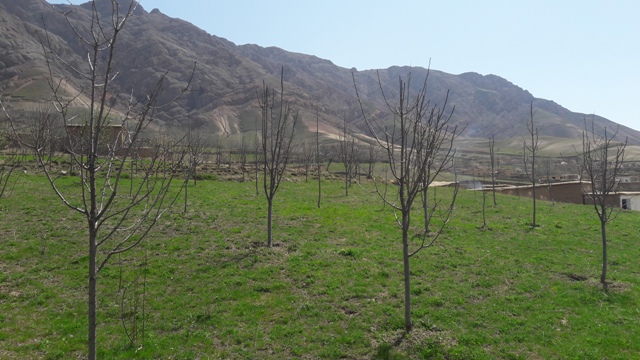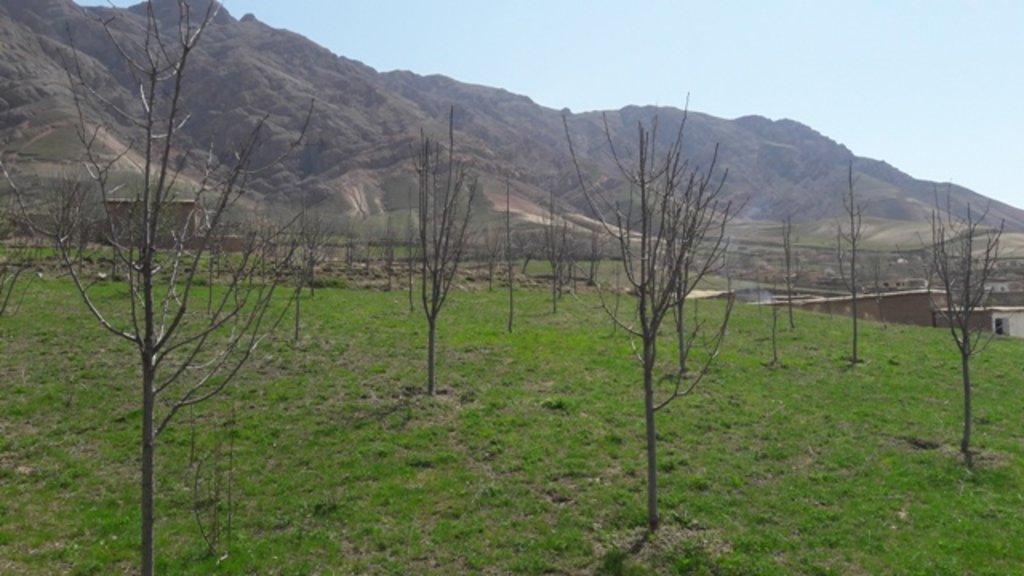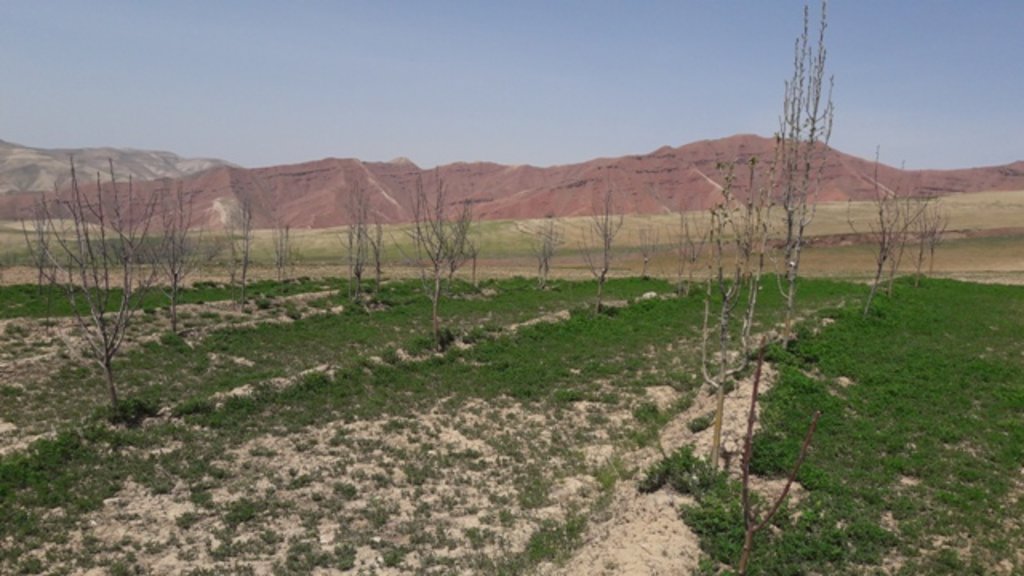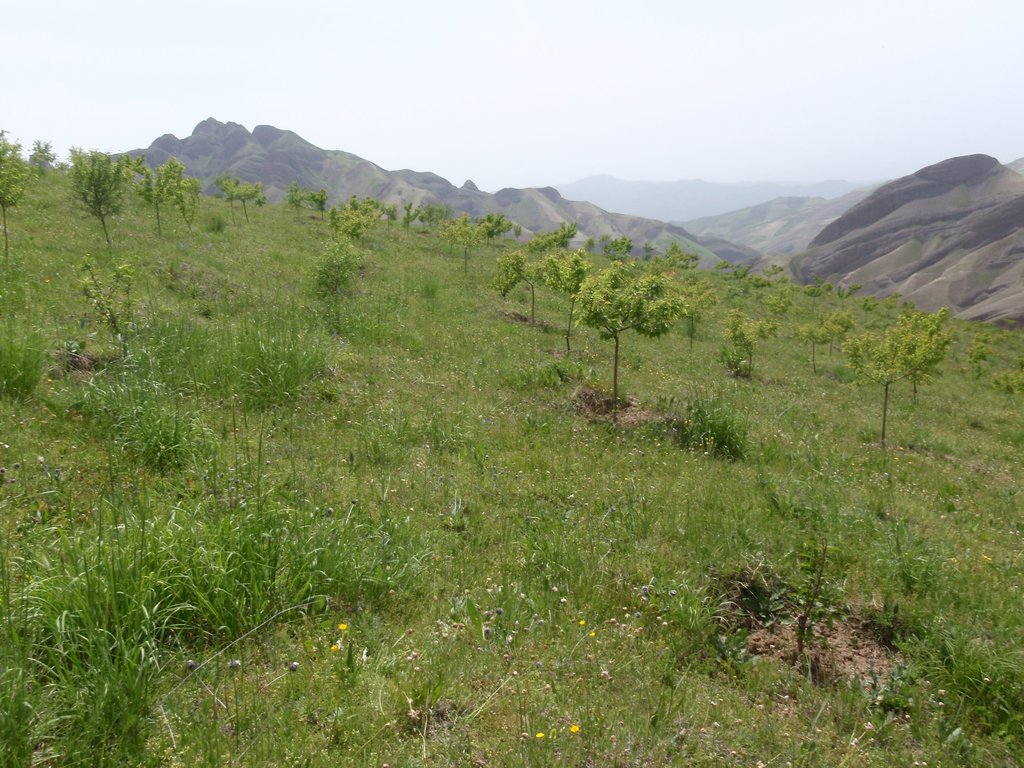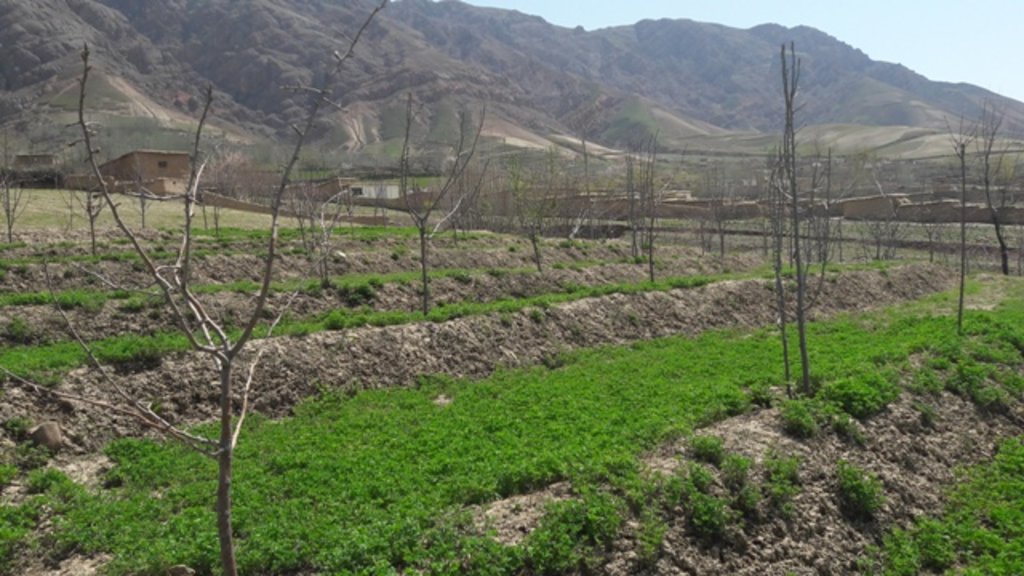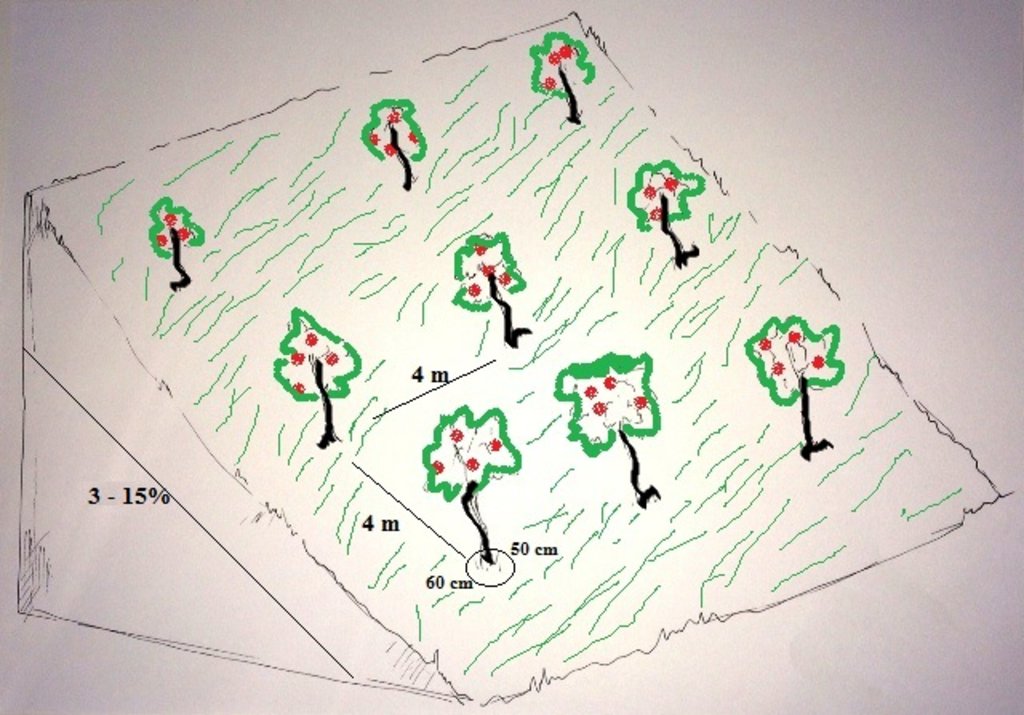Establishment of improved orchards and vineyards [أفغانستان]
- تاريخ الإنشاء:
- تحديث:
- جامع المعلومات: Bettina Wolfgramm
- المحرر: Roziya Kirgizbekova
- المُراجع: Rima Mekdaschi Studer
Bunyodi boghi va boghi anguri behbudyofta
technologies_669 - أفغانستان
عرض الأقسام
توسيع الكل طي الكل1. معلومات عامة
1.2 تفاصيل الاتصال بالأشخاص الرئيسيين لمصدر المعلومات والمؤسسات المشاركة في تقييم وتوثيق التقنية
الشخص (الأشخاص) الرئيسي لمصدر المعلومات
مستخدم الأرض:
Mirza Bay Gholam Sakhi
Natural Resources Management Comittee (NRMC)
أفغانستان
متخصص في الإدارة المستدامة للأراضي:
متخصص في الإدارة المستدامة للأراضي:
Researcher:
اسم المشروع الذي سهّل توثيق/تقييم التقنية (إذا كان ذلك على صلة)
Livelihood Improvement Project Takhar, Afghanistan (LIPT)اسم المشروع الذي سهّل توثيق/تقييم التقنية (إذا كان ذلك على صلة)
Potential and limitations for improved natural resource management (NRM) in mountain communities in the Rustaq district, Afghanistan (Rustaq NRM Study)اسم المؤسسة (المؤسسات) التي سهلت توثيق/تقييم التقنية (إذا كان ذلك على صلة)
Terre des Hommes (Terre des Hommes) - سويسرااسم المؤسسة (المؤسسات) التي سهلت توثيق/تقييم التقنية (إذا كان ذلك على صلة)
Swiss Agency for Development and Cooperation (DEZA / COSUDE / DDC / SDC) - سويسرااسم المؤسسة (المؤسسات) التي سهلت توثيق/تقييم التقنية (إذا كان ذلك على صلة)
Bern University of Applied Sciences, School of Agricultural, Forest and Food Sciences (HAFL) - سويسرااسم المؤسسة (المؤسسات) التي سهلت توثيق/تقييم التقنية (إذا كان ذلك على صلة)
CDE Centre for Development and Environment (CDE Centre for Development and Environment) - سويسرا1.3 الشروط المتعلقة باستخدام البيانات الموثقة من خلال WOCAT
يوافق جامع المعلومات والشخص (لاشخاص) الرئيسي لمصدر المعلومات على الشروط المتعلقة باستخدام البيانات الموثقة من خلال WOCAT:
نعم
1.4 إعلان بشأن استدامة التقنية الموصوفة
هل التقنية الموصوفة هنا تمثل مشكلة فيما يتعلق بتدهور الأراضي، بحيث لا يمكن إعلانها تقنية مستدامة لإدارة الأراضي؟:
كلا
التعليقات:
SLM practices documented in the frame of the Rustaq NRM study were established only recently (1-3 years ago). It is too early for a final judgment on the sustainability of these technologies within the human and natural environment of Chokar watershed.
2. وصف تقنيةالإدارة المستدامي للأراضي
2.1 وصف مختصر للتقنية
تعريف التقنية:
Local and new varieties of fruits are planted on degraded land in accordance with improved management practices. The established orchards and vineyards serve double purpose of soil protection and income generation for the rural households. The alfalfa under the trees supports tree growth and is used for livestock fodder.
2.2 وصف تفصيلي للتقنية
الوصف:
Project supported implementation of improved orchards and vineyards has taken place in the villages Sari Joy, Jawaz Khana and Dashti Mirzai, located in Chokar watershed of Rustaq District in Northern Afghanistan. The Chokar watershed is a mountainous area situated between 600 - 2,500 m above sea level. The climate is semi-arid with harsh and cold weather in winter and hot and dry summers. The annual precipitation in average years is 580mm. Land degradation affects all forms of land use and includes low vegetation cover, heavy top soil erosion from water, and poor soil fertility. Unsustainable agricultural practices, over-exploitation and high pressure on the natural resources are adversely impacting on the socio-economic well-being of local communities as well as contributing to the risk for being adversely affected by drought as well as landslides and flash foods triggered by heavy rainfall. The data used for the documentation of the technology is based on field research conducted in Chokar watershed, namely in the villages: Sari Joy, Jawaz Khana and Dashti Mirzai. These villages represent the upper, the middle and the lower zone of Chokar watershed, respectively. They differ considerably in access to services and infrastructure, but in general are poorly served. The communities depend on land resources for sustaining their livelihoods. In a good year with high yields, wheat-self-sufficiency lasts about 5 months. The three villages are home to ethnic Qarluq communities. Since 2012 the Livelihood Improvement Project Takhar (LIPT) implemented by Terre des hommes (Tdh) Switzerland has initiated a range of NRM interventions.
The rural population in Rustaq district of Afghanistan traditionally grows local varieties of apples, pears and grapes. Mostly it is subsistence farming with a small-scale local marketing. Shortage of irrigation water and lack of specific knowledge about horticultural and viticulture practices, negatively affects fruit yields. Apart of providing diverse fruits for consumption, orchards are also important for providing fodder for the livestock, retaining soil moisture and protecting the soil from erosion.
The local land users interested in the establishment of improved orchards and vineyards were mobilized through the Natural Resources Management Committees (NRMC) in Sari Joy, Jawaz Khana and Dashti Mirzai villages. In addition to the local varieties of pears, apples and grapes, new improved varieties were used for orchards and vineyards on 6.5 ha of degraded land. Such orchards were established inside or close to the villages on mountain slopes with gentle (3-5%) and moderate (6 -15%) steepness. Fruit trees are planted on locally identified dark and light soils, which correspond to moderately deep and loamy soil of medium soil fertility. Considering the medium quality of the soil, the first step of tree plantation is application of organic fertilizer. Afterwards, the plot is designed according to 4m x 4 m spacing between the trees. Under such parameters, on 1 jirib (0.2 ha) of land 125 fruit tree (apple or pear) seedlings are planted. The depth of the planting pits is 60 x 50 cm. The planted tree is watered and the lower trunk is covered with lime and water solution. Alfalfa is sown under the trees to serve as a fodder for the livestock. The orchards are irrigated mostly during summer once a week. In areas where there is shortage of irrigation water the trees are rainfed. Other maintenance activities include pest and disease control provided by a trained local specialist.
The new orchards only recently started giving fruits. The actual fruit yields are expected in 2017-2018. Expected higher yields of improved verities of pears, apples and grapes serves as a strong incentive for the local land users and their families to establish and maintain the orchards. Orchards are very demanding, but their reward is very promising in terms of improved harvest and more opportunities to sell the produce. Some land users have successful experience on their plots and already have fruits in their gardens and plan to enlarge their garden and plant more varieties of fruit trees, such as persimmons. Alfalfa which grows under the trees has important production value, particularly during the early years after the establishment phase, when the trees are too young to give fruits.
Female members of the households, which implemented orchards are also involved in establishing and maintaining orchards and vineyards. They take part in planting trees, watering, hay making and protecting the trees from livestock and people. Their contribution, plays an important part for the successful implementation of improved orchards and vineyards in Sari Joy, Jawaz Khana and Dashti Mirzai.
2.3 صور التقنية
2.5 البلد/المنطقة/المواقع التي تم تنفيذ التقنية فيها والتي يغطيها هذا التقييم
البلد:
أفغانستان
المنطقة/الولاية/المحافظة:
Takhar Province, Rustaq District
مزيد من التفاصيل حول الموقع:
Sari Joy, Jawaz Khana, Dashti Mirzai
حدد انتشار التقنية:
- منتشرة بالتساوي على مساحة
إذا كانت المساحة الدقيقة غير معروفة، فيرجى الإشارة إلى المنطقة التقريبية المغطاة:
- < 0.1 كم2 (10 هكتار)
التعليقات:
This documentation is based on the experiences of SLM implementers from Sari Joy (8 plots), Jawaz Khana, (6 plots), and Dashti Mirzai (3 plots). Additionally insights were gained through interviews with both SLM implementers and observers from all three villages.
Map
×2.6 تاريخ التنفيذ
في حالة عدم معرفة السنة بالتحديد، يرجى الإشارة إلى التاريخ التقريبي:
- منذ أقل من 10 سنوات (مؤخرًا)
2.7 إدخال التقنية
حدد كيف تم إدخال التقنية:
- من خلال المشاريع/ التدخلات الخارجية
التعليقات (نوع المشروع، الخ):
Livelihood Improvement Project Takhar (LIPT) supported by Swiss Development Cooperation (SDC) from 2012-17
3. تصنيف تقنية الإدارة المستدامي للأراضي
3.1 الغرض الرئيسي ( الأغراض الرئيسية) للتقنية
- تحسين الإنتاج
3.2 نوع (أنواع) استخدام الأراضي الحالية حيث يتم تطبيق التقنية
استخدامات الأراضي مختلطة ضمن نفس وحدة الأرض:
نعم
حدد استخدام الأراضي المختلطة (المحاصيل / الرعي / الأشجار):
- الرعي الزراعي الحرجي

الأراضي الزراعية
- زراعة سنوية
- زراعة معمرة (غير خشبية)
- زراعة الأشجار والشجيرات
الزراعة السنوية - حدد المحاصيل:
- محاصيل الأعلاف - البرسيم (الفصة)
زراعة الأشجار والشجيرات -حدد المحاصيل:
- أشجار العلف (كالياندرا، لوسينا، المسكيت، إلخ.)
- العنب
- الثمار التفاحية (التفاح، الكمثرى، السفرجل، الخ)
- أشجار الجوزيات (جوز البرازيل، الفستق، الجوز، اللوز، الخ.)
عدد مواسم الزراعة في السنة:
- 1

أراضي الرعي

الغابات/ الأراضي الحرجية
3.3 هل تغير استخدام الأراضي نتيجة لتنفيذ التقنية؟
هل تغير استخدام الأراضي نتيجة لتنفيذ التقنية؟:
- نعم (يرجى ملء الأسئلة أدناه فيما يتعلق باستخدام الأراضي قبل تنفيذ التقنية)

الأراضي الزراعية
التعليقات:
About half of orchard plots are established on cropland.
3.4 إمدادات المياه
إمدادات المياه للأرض التي يتم تنفيذ التقنية عليها:
- مختلط بعلي-مروي
التعليقات:
Often the trees are watered with supplementary irrigation, from irrigation channels, or fetching the water in buckets.
3.5 مجموعةالإدارة المستدامة للأراضي التي تنتمي إليها هذه التقنية
- الحراجة الزراعية
3.6 التدابير التقنية في مجال إلادارة المستدامة للأراضي

التدابير النباتية
- V1: غطاء من الأشجار والشجيرات
- V2: الأعشاب والنباتات العشبية المعمرة

التدابير الإدارية
- M1: التغيير في نوع استخدام الأراضي
التعليقات:
Many land users establish a fence around their orchards to protect the trees from animal and the fruits from theft.
3.7 الأنواع الرئيسية من تدهور الأراضي التي تناولتها التقنية

تآكل التربة بالمياه
- الوزن(Wt): فقدان التربة السطحية/تآكل السطح

تآكل التربة الناتج عن الرياح
- (Et): فقدان التربة السطحية

التدهور البيولوجي
- (Bc): تناقص الغطاء النباتي
- (Bq): انخفاض الكمية/الكتلة الحيوية

تدهور المياه
- (Ha): التجفيف
3.8 منع أو حد أو عكس تدهور الأراضي
تحديد هدف التقنية فيما يتعلق بتدهور الأراضي:
- منع تدهور الأراضي
- الحد من تدهور الأراضي
4. المواصفات الفنية، وأنشطة التنفيذ، والمدخلات، والتكاليف
4.1 الرسم الفني للتقنية
المواصفات الفنية (المتعلقة بالرسم الفني):
Orchards are established on mountain slopes with gentle (3-5%) and moderate (6-10%) steepness. Considering the medium soil fertility, the first step of tree plantation is application of organic fertilizer. Afterwards, the plot is designed according to 4m x 4 m spacing between rows and trees. Under such parameters, on 1 jirib (0.2 ha) of land 125 fruit tree (apple or pear) seedlings are planted. The depth of the planting pits is 60 x 50 cm. The planted tree is watered and the lower trunk is covered with lime and water solution. Alfalfa is sown under the trees for livestock fodder.
المؤلف:
Aslam Qadamov; Roziya Kirgizbekova
التاريخ:
03/04/2017
4.2 معلومات عامة بخصوص حساب المدخلات والتكاليف
حدد كيفية احتساب التكاليف والمدخلات:
- حسب مساحة تنفيذ التقنية
الإشارة إلى حجم ووحدة المساحة:
1 ha
حدد العملة المستخدمة لحساب التكاليف:
- دولار أمريكي USD
إذا كان ذا صلة، وضح سعر الصرف من الدولار الأمريكي إلى العملة المحلية (على سبيل المثال، 1 دولار أمريكي = 79.9 ريال برازيلي): 1 دولار أمريكي =:
67,0
اذكر متوسط تكلفة أجر العمالة المستأجرة في اليوم الواحد:
5.2-5.3 USD per day
4.3 أنشطة التأسيس
| النشاط | التوقيت (الموسم) | |
|---|---|---|
| 1. | Selection of the area for orchard (Men) | Fall |
| 2. | Applicatoin of manure (Men) | Fall/Winter |
| 3. | Design of tree spacing in the orchard assisted by project staff (Men) | End of winter |
| 4. | Digging pits for planting (Men/Women) | Spring |
| 5. | Planting of fruit trees (Men/Women) | Spring |
| 6. | Sowing of alfalfa under the trees (Men/Women) | Spring |
4.4 التكاليف والمدخلات اللازمة للتأسيس
| تحديد المدخلات | الوحدة | الكمية | التكاليف لكل وحدة | إجمالي التكاليف لكل مدخل | % من التكاليف التي يتحملها مستخدمو الأراضي | |
|---|---|---|---|---|---|---|
| العمالة | Application of manure | person-day | 5,0 | 5,3 | 26,5 | 83,0 |
| العمالة | Design of tree spacing | person-day | 5,0 | 5,3 | 26,5 | |
| العمالة | Digging pits for planting | person-day | 15,0 | 5,3 | 79,5 | 83,0 |
| العمالة | Planting trees, sowing alfalfa and watering | person-day | 10,0 | 5,3 | 53,0 | 83,0 |
| معدات | Meter | piece | 1,0 | 2,25 | 2,25 | |
| معدات | Rope | Meter | 500,0 | 0,07 | 35,0 | |
| معدات | Shovel | piece | 2,0 | 3,8 | 7,6 | |
| معدات | Pick axe | piece | 1,0 | 2,25 | 2,25 | |
| المواد النباتية | Seedlings (apple/pear) | piece | 625,0 | 0,75 | 468,75 | |
| المواد النباتية | Alfalfa seeds | kg | 17,5 | 0,42 | 7,35 | |
| الأسمدة والمبيدات الحيوية | DAP | Kg | 250,0 | 0,9 | 225,0 | |
| الأسمدة والمبيدات الحيوية | Urea | Kg | 250,0 | 0,45 | 112,5 | |
| الأسمدة والمبيدات الحيوية | Animal manure | ton | 10,0 | 60,0 | 600,0 | |
| الأسمدة والمبيدات الحيوية | Pesticide | cc | 500,0 | 0,9 | 450,0 | |
| الأسمدة والمبيدات الحيوية | Lime | Kg | 25,0 | 1,5 | 37,5 | |
| إجمالي تكاليف إنشاء التقنية | 2133,7 | |||||
| إجمالي تكاليف إنشاء التقنية بالدولار الأمريكي | 31,85 | |||||
إذا تحمل مستخدم الأرض أقل من 100% من التكاليف، حدد من قام بتغطية التكاليف المتبقية:
Livelihood Improvement Project Takhar (LIPT) implemented by Terre des hommes (Tdh) Switzerland
التعليقات:
Costs calculated for a Technology area of 1ha was only done for the purpose of the WOCAT documentation. In reality SLM plots are on average 0.2- 0.4 ha or 1- 2 jiribs. Costs were simply multiplied by 5. The actual costs for a 1ha plot might be slightly different.
4.5 الصيانة/الأنشطة المتكررة
| النشاط | التوقيت/الوتيرة | |
|---|---|---|
| 1. | Watering of the trees (Men/Women) | 2 times/month/Summer |
| 2. | Weeding (Women) | |
| 3. | Pruning (Men) | |
| 4. | Lime application (Men) | |
| 5. | Hay making (Men/Women) | |
| 6. | Harvesting fruits (Men/Women) |
4.6 التكاليف والمدخلات اللازمة للصيانة/للأنشطة المتكررة (سنويًا)
| تحديد المدخلات | الوحدة | الكمية | التكاليف لكل وحدة | إجمالي التكاليف لكل مدخل | % من التكاليف التي يتحملها مستخدمو الأراضي | |
|---|---|---|---|---|---|---|
| العمالة | Irrigation | person day | 5,0 | 5,3 | 26,5 | 100,0 |
| العمالة | Weeding | person day | 5,0 | 5,3 | 26,5 | 100,0 |
| العمالة | Pruning | person day | 5,0 | 5,3 | 26,5 | 100,0 |
| العمالة | Lime application | person day | 5,0 | 5,3 | 26,5 | 100,0 |
| معدات | Scissors for pruning | piece | 2,0 | 9,0 | 18,0 | |
| الأسمدة والمبيدات الحيوية | Lime | Kg | 25,0 | 1,5 | 37,5 | 100,0 |
| إجمالي تكاليف صيانة التقنية | 161,5 | |||||
| إجمالي تكاليف صيانة التقنية بالدولار الأمريكي | 2,41 | |||||
إذا تحمل مستخدم الأرض أقل من 100% من التكاليف، حدد من قام بتغطية التكاليف المتبقية:
Livelihood Improvement Project Takhar (LIPT) implemented by Terre des Hommes (Tdh) Switzerland
التعليقات:
Costs calculated for a Technology area of 1ha was only done for the purpose of the WOCAT documentation. In reality SLM plots are on average 0.2- 0.4 ha or 1- 2 jiribs. Costs were simply multiplied by 5. The actual costs for a 1ha plot might be slightly different.
4.7 أهم العوامل المؤثرة على التكاليف
قدم وصفا لأهم العوامل التي تؤثر على التكاليف:
Due to the remoteness of the villages where the Technology has been implemented, all the inputs for establishment, such as agricultural equipment, plant material, fertilizers, etc., are purchased in Rustaq town. The expenses for traveling and delivering the inputs affect the establishment costs.
5. البيئة الطبيعية والبشرية
5.1 المناخ
هطول الأمطار السنوي
- < 250 مم
- 251- 500 ملم
- 501 - 750ملم
- 1,000-751 ملم
- 1,500-1,100 ملم
- 2,000-1,500 ملم
- 3,000-2,001 ملم
- 4,000-3,100 ملم
- > 4000 ملم
حدد متوسط هطول الأمطار السنوي (إذا كان معروفًا)، بالملليمتر:
580,00
المواصفات/التعليقات على هطول الأمطار:
Average annual percipitation for the area was calculated with 580 mm, with minimums in dry years (2000 and 2001) of 270 mm and maximums in wet years (2009/2010) of 830 mm. The absolut maximum rainfall was calculated for 1986 with 1024 mm. The data series covers the time from 1979 to 2014.
الإشارة إلى اسم محطة الأرصاد الجوية المرجعية المعنية:
Climate Forecast System Reanalysis (CFSR), http://rda.ucar.edu/pub/cfsr.html
المنطقة المناخية الزراعية
- شبه قاحلة
Derived from the publicly available dataset on length of growing period (LGP) (Fischer 2009 / IIASA-FAO). Internet link: http://tiles.arcgis.com/tiles/P8Cok4qAP1sTVE59/arcgis/rest/services/Length_of_growing_period/MapServer
5.2 طوبوغرافيا
متوسط الانحدارات:
- مسطح (0-2%)
- بسيط (3-5%)
- معتدل (6-10%)
- متدحرج (11-15%)
- تلال (16-30%)
- شديدة الانحدار(31-60%)
- فائقة الانحدار (>60%)
التضاريس:
- هضاب/سهول
- أثلام مرتفعة
- المنحدرات الجبلية
- منحدرات التلال
- منحدرات في السفوح
- قاع الوادي
المنطقة الارتفاعية:
- 100-0 متر فوق سطح البحر
- 500-101 متر فوق سطح البحر
- 1,000-501 متر فوق سطح البحر
- 1,500-1,001 متر فوق سطح البحر
- 2,000-1,501 متر فوق سطح البحر
- 2,500-2,100 متر فوق سطح البحر
- 3,000-2,501 متر فوق سطح البحر
- 4,000-3,001 متر فوق سطح البحر
- > 4000 متر فوق سطح البحر
5.3 التربة
متوسط عمق التربة:
- ضحل جدًا (0-20 سم)
- ضحلة (21-50 سم)
- متوسطة العمق (51-80 سم)
- عميقة (81-120 سم)
- عميقة جدًا (> 120 سم)
قوام التربة (التربة السطحية):
- متوسط ( طميي، سلتي)
قوام التربة (> 20 سم تحت السطح):
- متوسط ( طميي، سلتي)
المواد العضوية في التربة السطحية:
- متوسطة (1-3%)
- منخفضة (<1%)
إذا كان متاحًا، قم بإرفاق وصف كامل للتربة أو تحديد المعلومات المتوفرة، على سبيل المثال نوع التربة، الرقم الهيدروجيني/ درجة حموضة التربة، قدرة التبادل الكاتيوني، النيتروجين، الملوحة وما إلى ذلك.
Local land users differentiate between the following soil types where orchards and vineyards are established:
- Light soil: moderately deep; texture medium; medium, low organic matter
- Dark soil: moderately deep; texture medium, medium; medium organic matter
5.4 توافر المياه ونوعيتها
منسوب المياه الجوفية:
50-5 م
توافر المياه السطحية:
متوسط
نوعية المياه (غير المعالجة):
مياه شرب جيدة
هل تعتبر ملوحة الماء مشكلة؟:
كلا
هل تحدث فيضانات في المنطقة؟:
نعم
الإنتظام:
بشكل عرضي
تعليقات ومواصفات أخرى بشأن نوعية المياه وكميتها:
Floods occur mainly during the rainy seasons in spring and autumn. Availability of surface water differs for the three study villages Sari Joy, Jawaz Khana, and Dashti Mirzai. Sari Joy has sources and good surface water availability. Jawaz Khana has poor water availability as water has to be fetched from a lower laying stream. Dashti Mirzai has good water availability also from an irrigation channel.
5.5 التنوع البيولوجي
تنوع الأنواع:
- منخفض
تنوع الموائل:
- منخفض
5.6 خصائص مستخدمي الأراضي الذين يطبقون التقنية
مستقر أو مرتحل:
- غير المترحل
التوجه السوقي لنظام الإنتاج:
- الكفاف (الإمداد الذاتي)
- مختلط (كفاف/ تجاري)
الدخل من خارج المزرعة:
- 10-50% من جميع الإيرادات
- >50% من إجمالي الدخل
المستوى النسبي للثروة:
- متوسط
- ثري
أفراداً أو مجموعات:
- فرد/أسرة معيشية
مستوى المكننة:
- عمل يدوي
الجنس:
- نساء
- رجال
عمر مستخدمي الأرضي:
- متوسط العمر
- كبار السن
اذكر الخصائص الأخرى ذات الصلة لمستخدمي الأراضي:
The land users in the area where the Technology is applied belong to the Uzbek ethnic minority group Qarluq.
Although the men are generally the main land users, however, women and children also take active part in the related work. The functions of men and women are clearly distinguished within the Afghan society. At the same time within the family this division of work and functions also results in men and women working hand-in-hand. An improvement of the family’s livelihood situation is expected to positively affect all family members. While, it is recognized that the involvement of women is key in order to secure basic human rights for everyone, to achieve good governance, sustainable development, and to efficiently contribute to poverty reduction (SDC 2004), it is also clear that a context sensitive approach is of high importance.
Women in rural Afghanistan are involved in many production and income generating activities that contribute to the overall household income, however, very few women own resources such as land and livestock, and their income generating options are fewer in comparison to that of men.
5.7 متوسط مساحة الأرض التي يستخدمها مستخدمو الأراضي الذين يطبقون التقنية
- < 0.5 هكتارا
- 0.5 - 1 هكتار
- 1 -2 هكتار
- 2 - 5 هكتار
- 5 - 15 هكتار
- 15 - 50 هكتار
- 50 - 100هكتار
- 500-100 هكتار
- 1,000-500 هكتار
- 10,000-1,000 هكتار
- > 10,000 هكتار
هل يعتبر هذا نطاقًا صغيرًا أو متوسطًا أو واسعا (في إشارة إلى السياق المحلي)؟:
- على نطاق متوسط
5.8 ملكية الأراضي، وحقوق استخدام الأراضي، وحقوق استخدام المياه
ملكية الارض:
- فردية، لا يوجد سند ملكية
حقوق استخدام الأراضي:
- فردي
حقوق استخدام المياه:
- مجتمعي (منظم)
التعليقات:
Those who own land and use water for irrigation are obliged to pay for the water. The payment is made both in kind and in cash to the Mirob - the person in charge of distributing water in the community. The amount of the payment varies from village to village.
6. الآثار والتصريحات الختامية
6.1 الآثار التي أظهرتها التقنية في الموقع
الآثار الاجتماعية والاقتصادية
الإنتاج
إنتاج المحاصيل
التعليقات/ حدد:
The local and new improved varieties of fruit trees planted and managed sustainably give better fruit yields. Enhanced fruit production is also due to proper and timely control of pests and disease.
إنتاج الأعلاف
التعليقات/ حدد:
The grass (alfalfa and sainfoin), which is planted under the fruit trees is used as fodder for livestock.
إنتاج حيواني
التعليقات/ حدد:
Indirect contribution to animal production is achieved through availability of more fodder for the livestock from the grass in the orchards. Animals also feed on the tree leaves in autumn.
إنتاج الخشب
التعليقات/ حدد:
Production of wood is limited. Fuel wood is made from seasonal pruning of the trees.
إنتاج الغابات غير الخشبية
تنوع المنتج
التعليقات/ حدد:
Multiple varieties of fruit trees are grown, also through grafting techniques.
منطقة الإنتاج
الآثار الاجتماعية والثقافية
الأمن الغذائي / الاكتفاء الذاتي
التعليقات/ حدد:
The new practice of establishing orchards and vineyards ensures better yields. New variety of fruits such as apples, pears, almonds and grapes improve the diversity of household's production and consumption. The households have better opportunity to earn more from selling their fresh and dried fruits on the local market.
المعرفة بالإدارة المستدامة للأراضي/تدهور الأراضي
التعليقات/ حدد:
Land users learned new methods of planting trees according to the soil conditions and water availability. They were trained with such skills as grafting, pruning, pest and disease control and were introduced to improved verities of fruit trees.
وضع الفئات المحرومة اجتماعيا واقتصاديا
التعليقات/ حدد:
Female headed households are not included. Technology is implemented on private land, therefore people without land are excluded. However, they have they opportunity to earn income as a hired worker for the SLM implementers.
الآثار الايكولوجية
دورة المياه / الجريان السطحي
الجريان السطحي
التربة
فقدان التربة
التنوع البيولوجي: الغطاء النباتي، الحيوانات
الغطاء النباتي
التعليقات/ حدد:
Improved vegetation cover resulting from the tree plantations and the grass.
6.2 الآثار التي أظهرتها التقنية خارج الموقع
الفيضان في اتجاه مجرى النهر
تراكم الطمي باتجاه مصب النهر
القدرة على التخفيف / الترشيح
قيّم الآثار خارج الموقع (القياسات):
These comments apply to 6.1 and 6.2:
- Socio-economic impacts: Individual SLM implementers were asked to rate the benefits from orchards and vineyards. They were asked to indicate production increase of crops; fodder; animals; wood; non-wood forest products; increase in product diversity; or production area. The most important increase they rated with 3, the second most with 2, others with 1 point. Averages of the points given by all implementers of orchards are reflected here.
- Similarly for the "ecological impacts" and on "off-site impacts": Individual SLM implementers were asked to rate the on-site and off-site impacts of orchards and vineyards on water; soil; and vegetation. They were asked to indicate the strength of impacts with three, two or one points. Averages of the points given by the orchard implementers are reflected here.
- Socio-cultural impacts: This section is answered by the scientists, based on information collected during focus group discussions, and interviews conducted with persons from the 3 villages where the LIPT project implemented the SLM practices.
6.3 تعرض التقنية وحساسيتها لتغير المناخ التدريجي والظواهر المتطرفة/الكوارث المرتبطة بالمناخ (كما يراها مستخدمو الأراضي)
الظواهر المتطرفة / الكوارث المرتبطة بالمناخ
الكوارث الجوية
| كيف تتعامل التقنية مع ذلك؟ | |
|---|---|
| عاصفة ممطرة محلية | جيدة جدا |
الكوارث المناخية
| كيف تتعامل التقنية مع ذلك؟ | |
|---|---|
| جفاف | جيدا |
التعليقات:
Based on the multi-criteria matrix: SLM implementers were asked to jointly discuss and rate how much the SLM technology reduced the lands vulnerability to drought and local rainstorms. Only vulnerability to the most prevalent climate extremes (drought and local rainstorms) was discussed. SLM technologies were rated as reducing vulnerability poorly, well, or very well. The average points reflected here are from multi-criteria matrixes compiled in three villages where the SLM technology had been implemented.
6.4 تحليل التكلفة والعائد
كيف يمكن مقارنة العوائد نسبة لتكاليف الإنشاء (من وجهة نظر مستخدمي الأراضي)؟
عوائد قصيرة الأجل:
ايجابي جدا
عوائد طويلة الأجل:
ايجابي جدا
التعليقات:
Based on the multi-criteria matrix: During the FGD with SLM implementers, a multi-criteria matrix was elaborated, and different SLM practices were rated. In the frame of this exercise, SLM implementers were asked to jointly discuss and rate short term (1-3 years) and long-term (10 years) returns of the SLM practice. As the SLM technology was only implemented 1-2 years ago, it is too early to compare benefits to maintenance costs. Farmers have little experience so far on the actual benefits of the SLM technology. The ratings are mostly based on expected benefits and not on actual benefits.
6.5 اعتماد التقنية
- 1-10%
إذا كان متاحًا، قم بتحديد الكمية (عدد الأسر المعيشية و/أو المساحةالمغطاة):
6.5 ha
من بين جميع الذين تبنوا التقنية، كم عدد الذين فعلوا ذلك بشكل تلقائي، أي دون تلقي أي حوافز مادية/مدفوعات؟:
- 11-50%
التعليقات:
Individual SLM implementers were asked whether they received support for implementing the Technology. Each indicated the type of support he received from the proposed options: "Full Support 100%, Some Support, No Support 0%". 18% have adopted the technology without receiving support.
6.6 التكيف
هل تم تعديل التقنية مؤخرًا لتتكيف مع الظروف المتغيرة؟:
نعم
أخرى (حدد):
protection
حدد تكيف التقنية(التصميم، المواد/الأنواع، الخ.):
Some of the land users built a wall around their orchard. The wall made from locally available clay material, protects the trees and the grass from animal and people intrusion.
6.7 نقاط القوة / المزايا / الفرص التي توفرها التقنية
| نقاط القوة/ المزايا/ الفرص من وجهة نظر مستخدمي الأراضي |
|---|
| The land users have high expectations about the benefits of the improved practices to grow fruit trees. They see the benefit of growing different types of fruits. Expectations are high about increased fruit yields and increased opportunities to sell more fresh and dried fruits and nuts on the local market. Fruits and nuts sell very well and can generate higher incomes for the households. |
| The ecological benefits of the orchards in protecting the soil from heavy rains is valued by the land users. The villagers mark improved vegetation cover as their villages are becoming greener with the fruit trees and the alfalfa in the orchards. |
| It is appreciated by the land users that they were introduced and provided with new varieties of fruits. They were also trained on planting and maintaining orchards and vineyards in accordance with local conditions and using such techniques as grafting, pruning, mulching, protection from pests and diseases, etc. |
| The orchards not only give fruits, but also are the source of fuel wood, which is made from pruning the trees. Considering that many households keep livestock, the grass under the trees and tree leaves are used to feed the livestock. In return livestock manure is used as organic fertilizer for the trees. |
| Some land users having seen the positive outcome of their work, are interested in enlarging their orchards. Others are ready to support those who want to plant fruit trees by sharing tree saplings or seedlings with them. |
| Women share the expectations of earning more money for their household through growing more fruits and selling them on the local market. In Dashti Mirzai and Jawaz Khana women are particularly excited over their grape, which still need some time to give yields. |
| نقاط القوة/ المزايا/ الفرص من وجهة نظر جامع المعلومات أو غيره من الاشخاص الرئيسيين لمصدر المعلومات |
|---|
| Better management practices in growing fruit trees will benefit the land user and the land through strengthening soil resistance to heavy rainfall and prevent erosion. Over the period of few more years the trees and undergrowth grass will significantly enhance infiltration and moisture retention in the soil, which in turn increase the vegetation cover and halt the degradation process. |
| The SLM knowledge obtained through project training is disseminating inside and beyond the villages, along with exchange of seedlings from new varieties of fruit trees. In addition to that, land users are aware of pest and disease control and have access to these services through trained specialist. |
| Households do not have to rely only on wheat and legumes, but are able to diversify their agricultural production even more. The expected opportunity to sell more fruits and nuts has the potential to increase households income. This in turn will enable the family to secure their food supply for longer periods. |
| Female family members' participation is one of the key elements for sustaining orchards and vineyards. Women highly value the importance of their work in orchards and the benefit it provides to their households. |
6.8 نقاط ضعف / مساوىء / مخاطر التقنية وسبل التغلب عليها
| نقاط الضعف/ المساوىء/ المخاطر من وجهة نظر مستخدم الأراضي | كيف يمكن التغلب عليها؟ |
|---|---|
| Lack of irrigation water is a crucial issue, especially in Jawaz Khana, which makes it very difficult for the land users to maintain their orchards. | Rehabilitate the Yakhdons. Yakhdon is a local storage method for collecting snow water in winter to be used for drinking and irrigation in spring and summer. One Yakhdon can provide water for up to six months. Several of these Yakhdons are destroyed and their rehabilitation would provide better access to water for Jawaz Khana. |
| The young trees are sensitive to droughts and need to be watered regularly to ensure that they survive. | |
| Establishment of orchards requires hard work and sufficient money from the land user to buy seedlings and in some cases to build a wall around the orchard or build an irrigation canal. |
| نقاط الضعف/ المساوىء/ المخاطر من وجهة نظر جامع المعلومات أو غيره من الاشخاص الرئيسيين لمصدر المعلومات | كيف يمكن التغلب عليها؟ |
|---|---|
| The establishment of orchards is reported as one of the most labour-intensive SLM practice for both men and women. Working in orchards increases the burden of women in addition to their household chores. | |
| Technical knowledge on planting and maintaining fruit trees and grapes is required to ensure tree survival, good productivity and protection from pests and diseases. |
7. المراجع والروابط
7.1 طرق جمع/مصادر المعلومات
- مقابلات مع مستخدمي الأراضي
Focus group discussions (FGD) were organized by CDE team to collect information from SLM implementers. Total of 17 land users who have implemented terraces participated in the FGDs held in the three villages of Sari Joy, Jawaz Khana and Dashti Mirzai.
Interviews were conducted by the HAFL team to collect information from persons representing all the three study villages. Very detailed interviews were conducted with 41 persons interested in orchard implementation, of which 14 persons are from households that already have implemented orchards.
- مقابلات مع المتخصصين/الخبراء في الإدارة المستدامة للأراضي
Close collaboration took place during the compilation of this material with the technical staff of the LIPT project in Rustaq.
- التجميع من التقارير والوثائق الأخرى الموجودة
Information provided in the reports of the LIPT project in Rustaq served as an initial source of information during the preparatory phase and also solidifying the description of the technology and area of implementation. Other background papers on Afghanistan were referred to for general information on agriculture and natural resource management in Afghanistan.
متى تم تجميع البيانات (ميدانيا)؟:
27/10/2016
7.2 المراجع للمنشورات المتاحة
العنوان، المؤلف، السنة، النظام القياسي الدولي لترقيم الكتب ISBN:
Guidelines for Focus Group Discussions
العنوان، المؤلف، السنة، النظام القياسي الدولي لترقيم الكتب ISBN:
Methods section of the Rustaq NRM study
الروابط والوحدات المواضيعية
توسيع الكل طي الكلالروابط
لا يوجد روابط
الوحدات المواضيعية
لا يوجد وحدات مواضيعية


